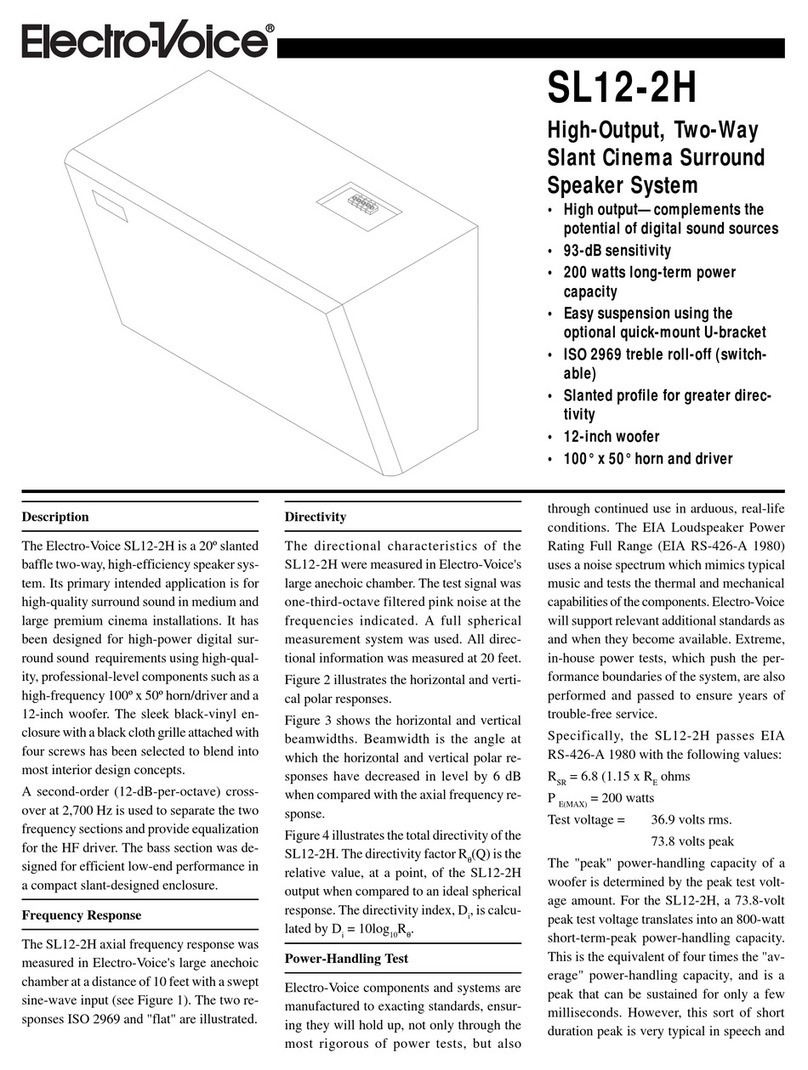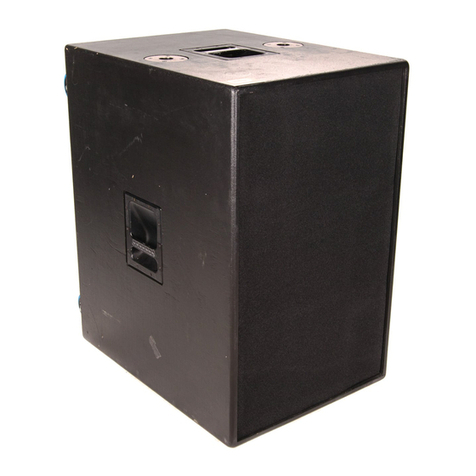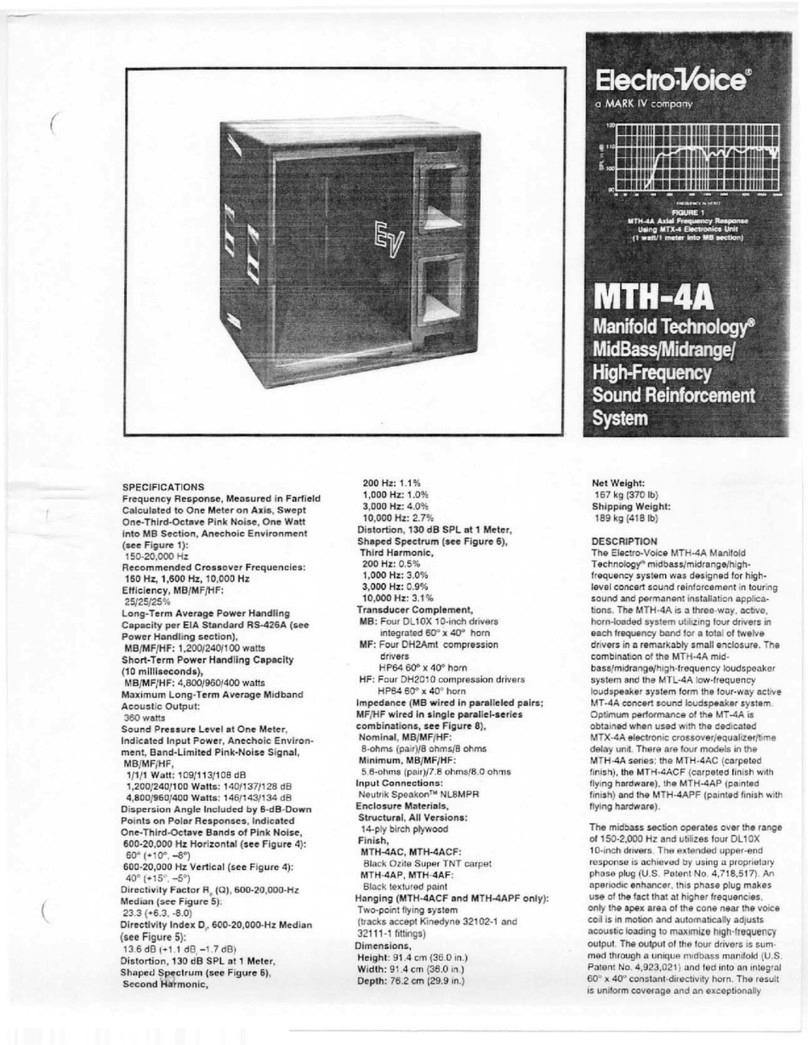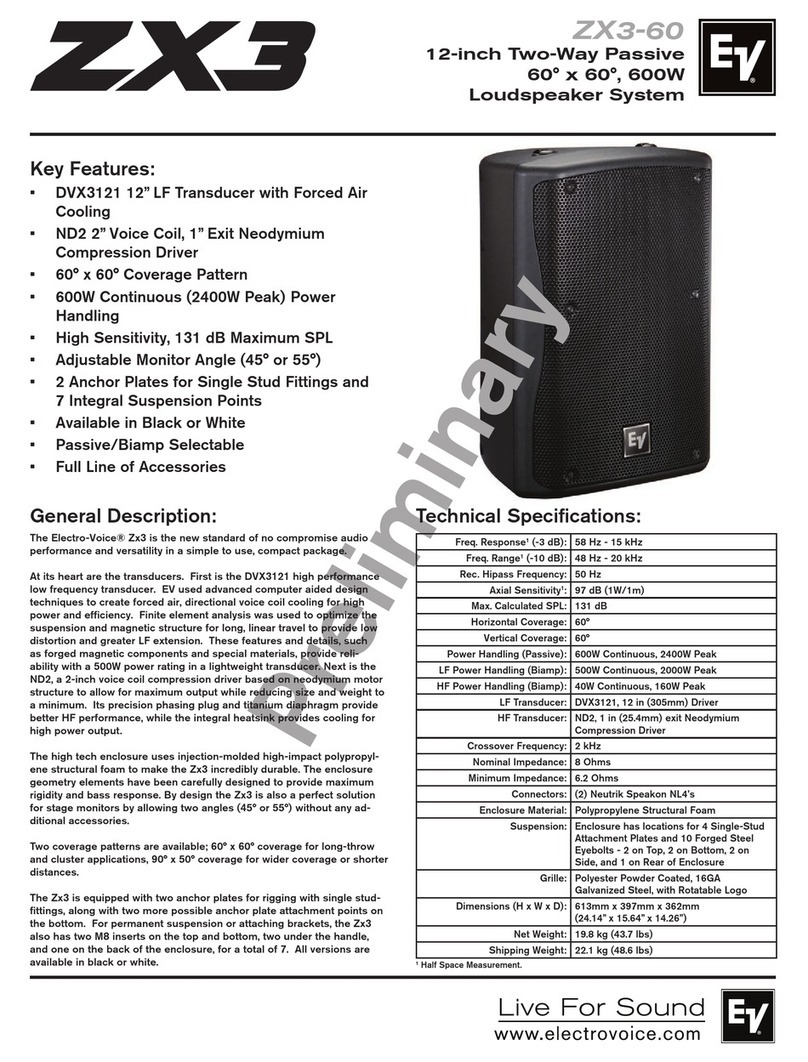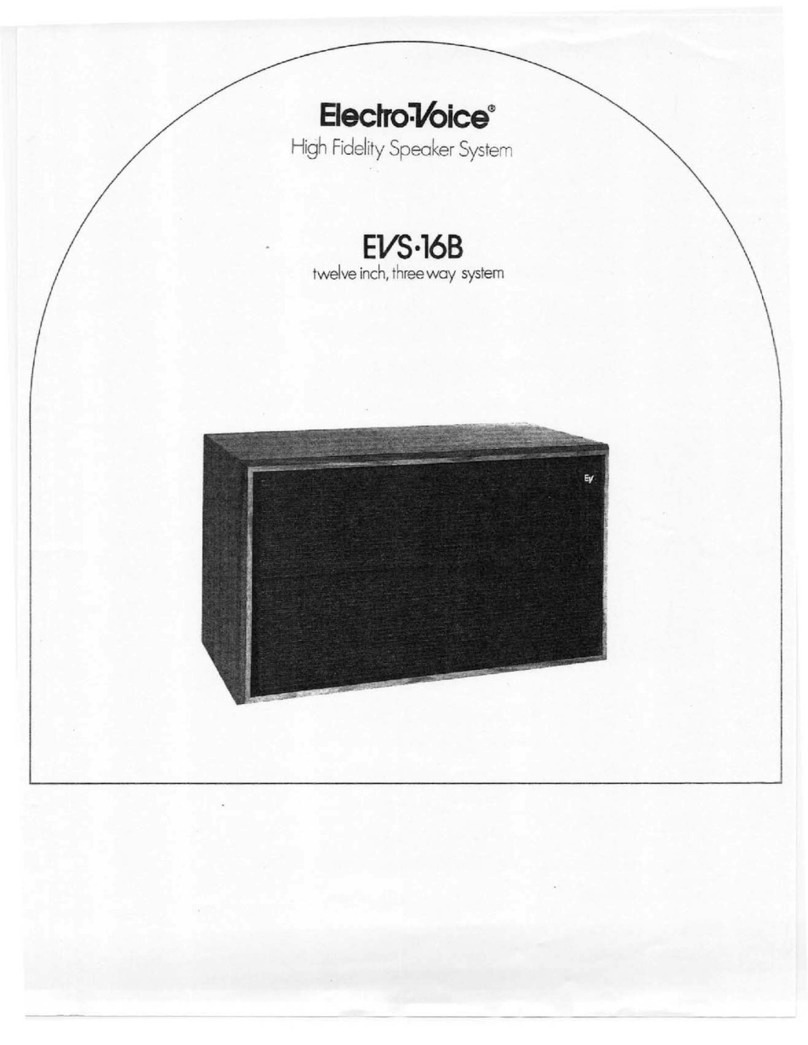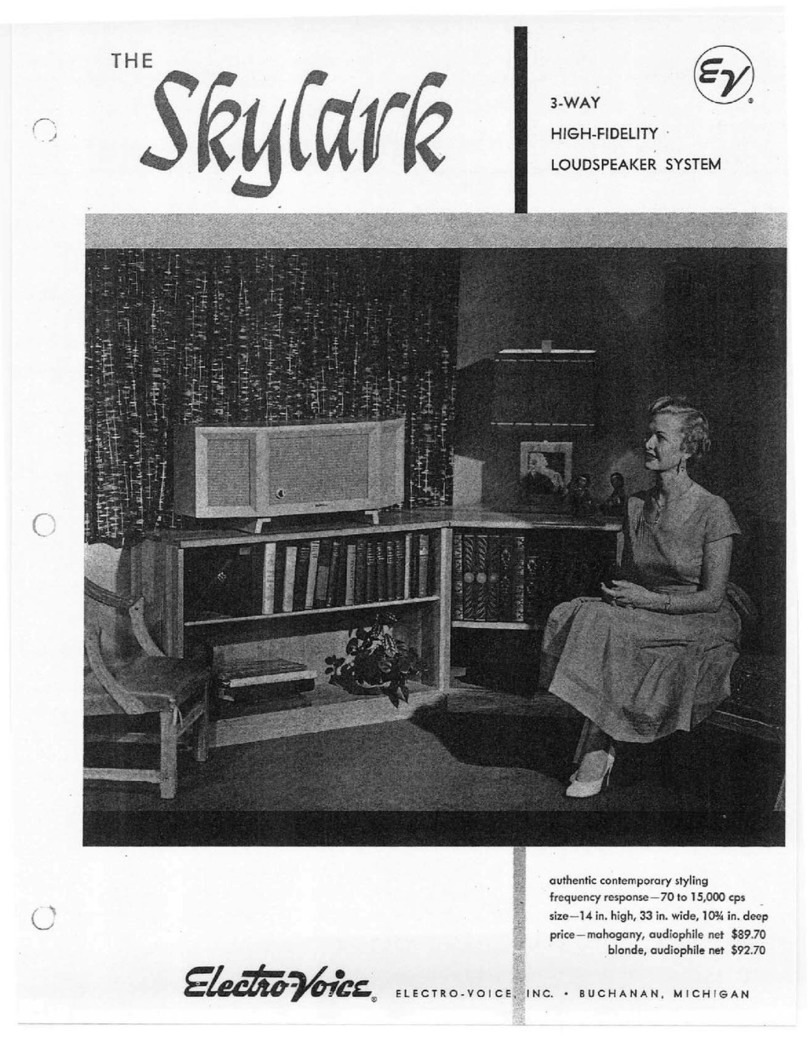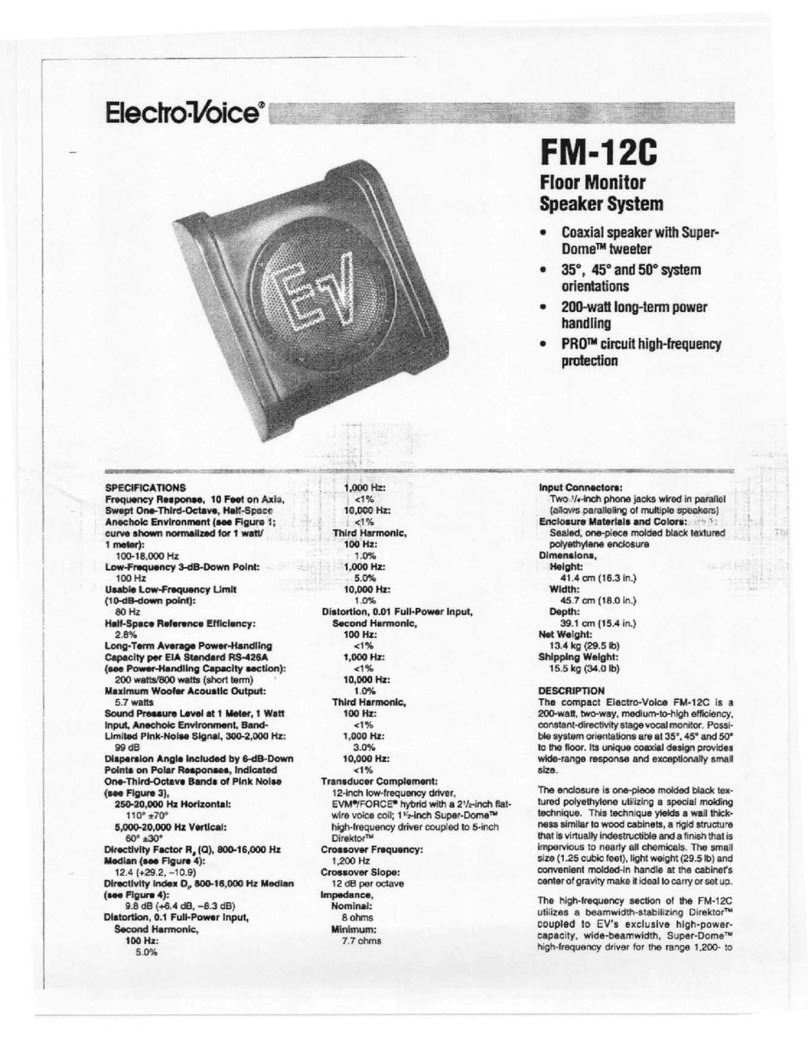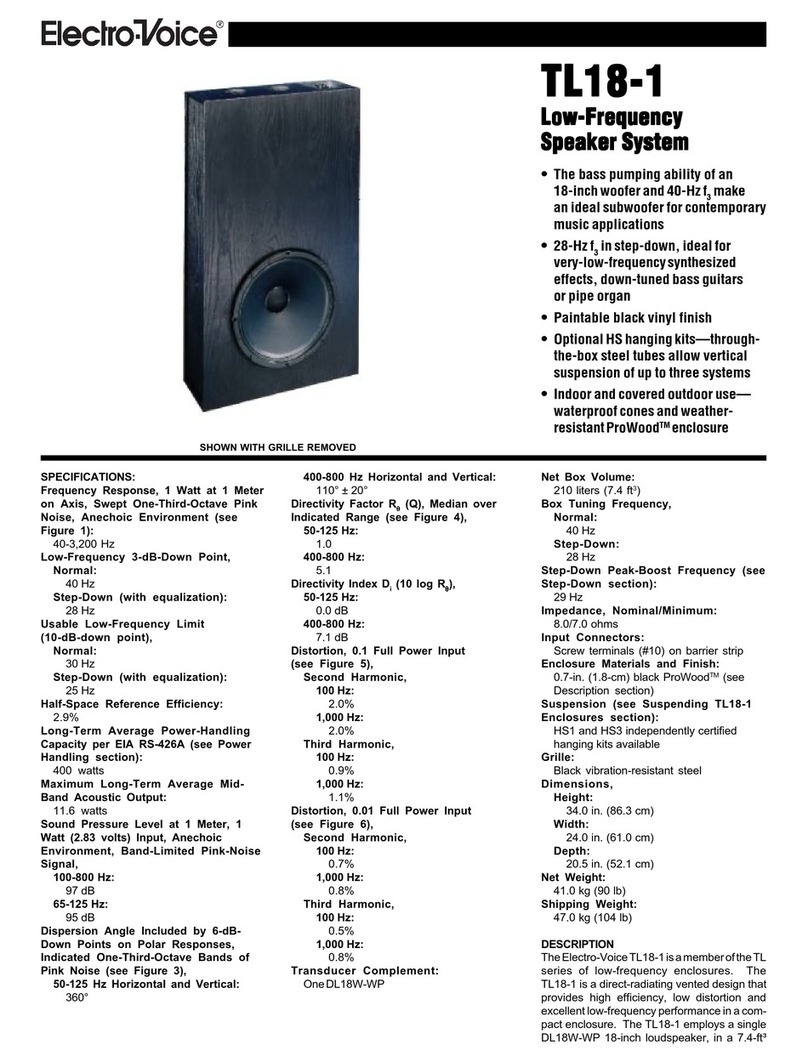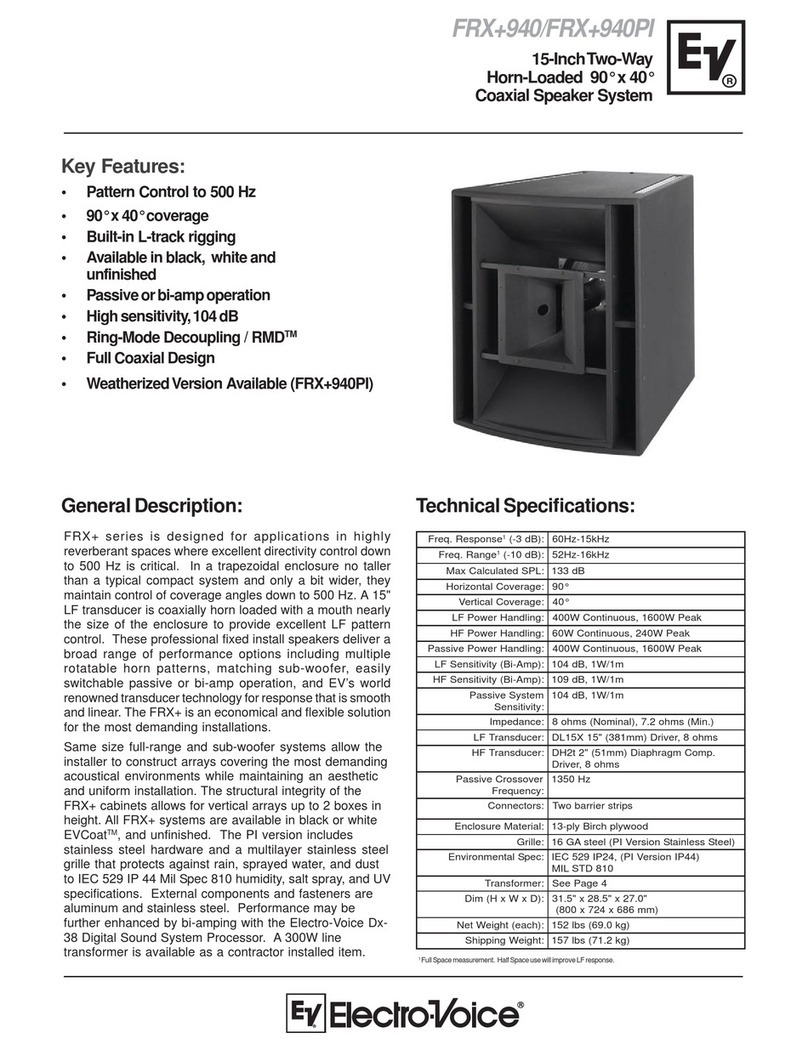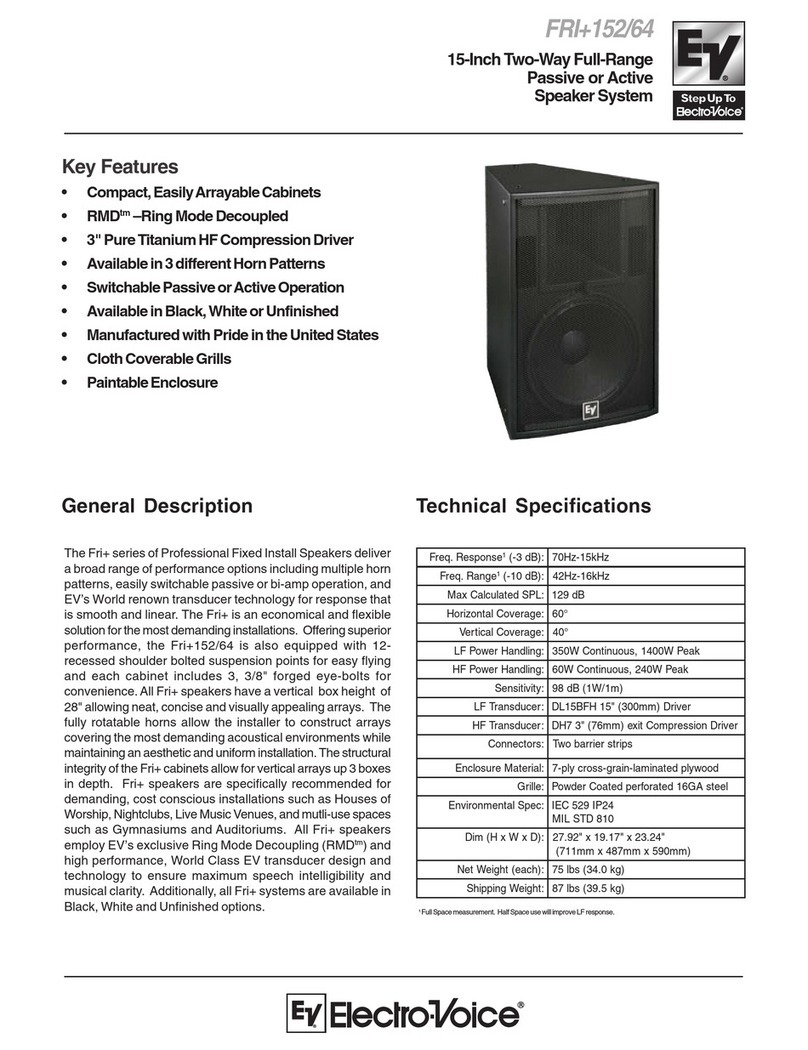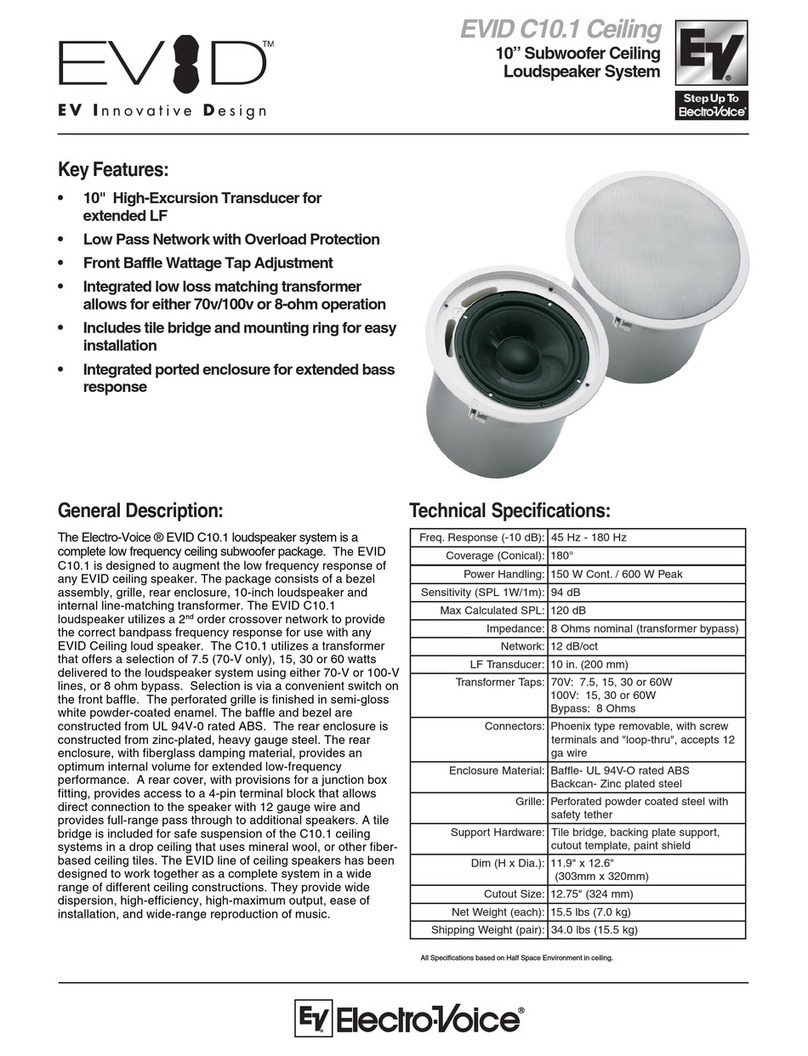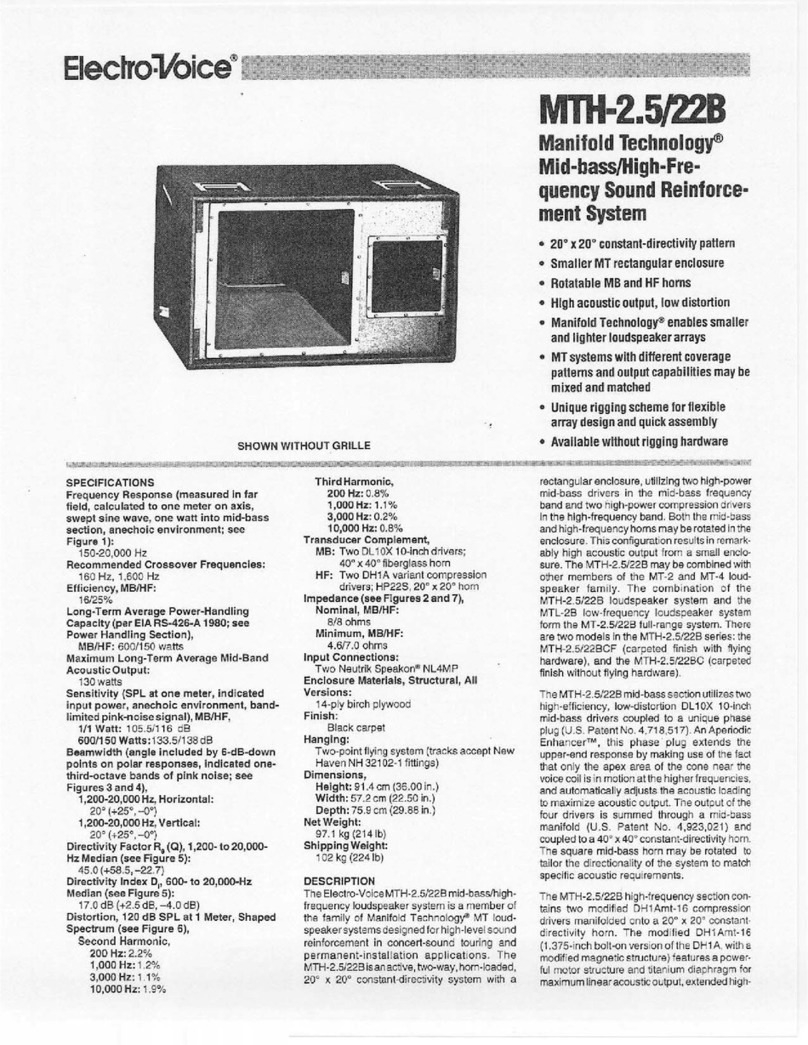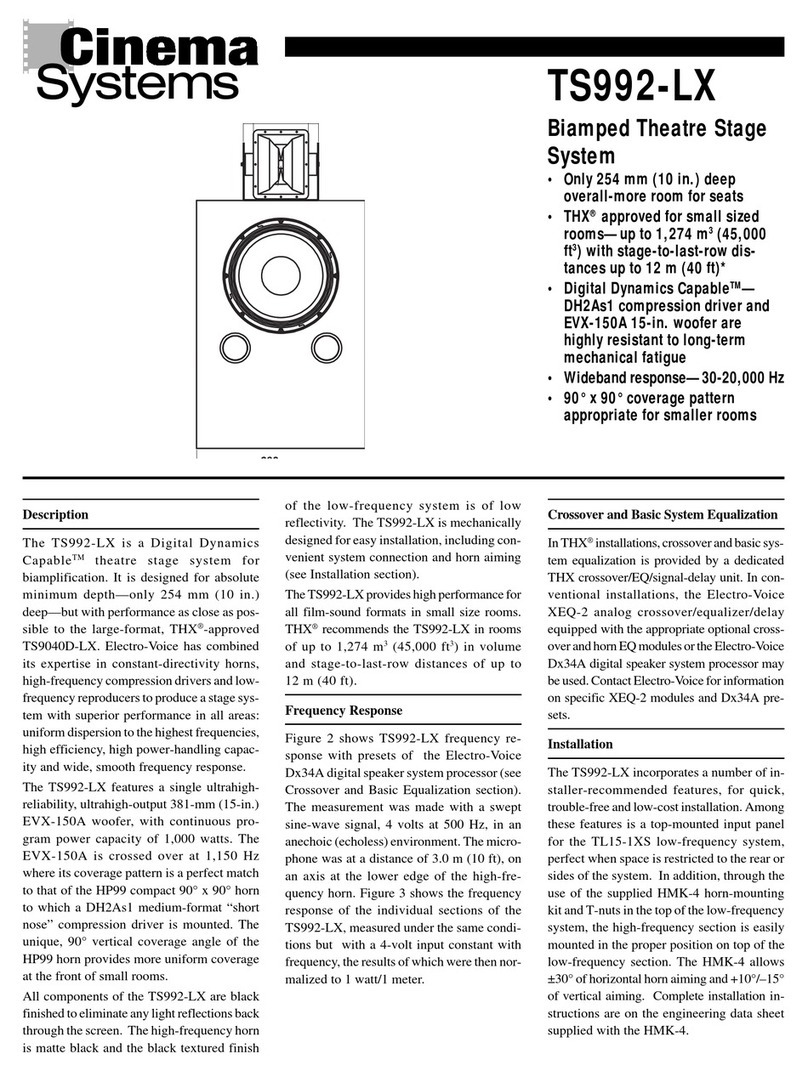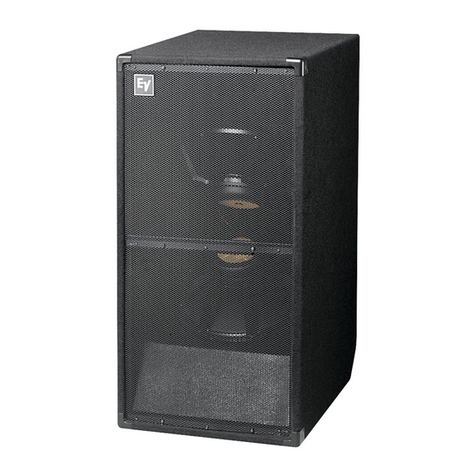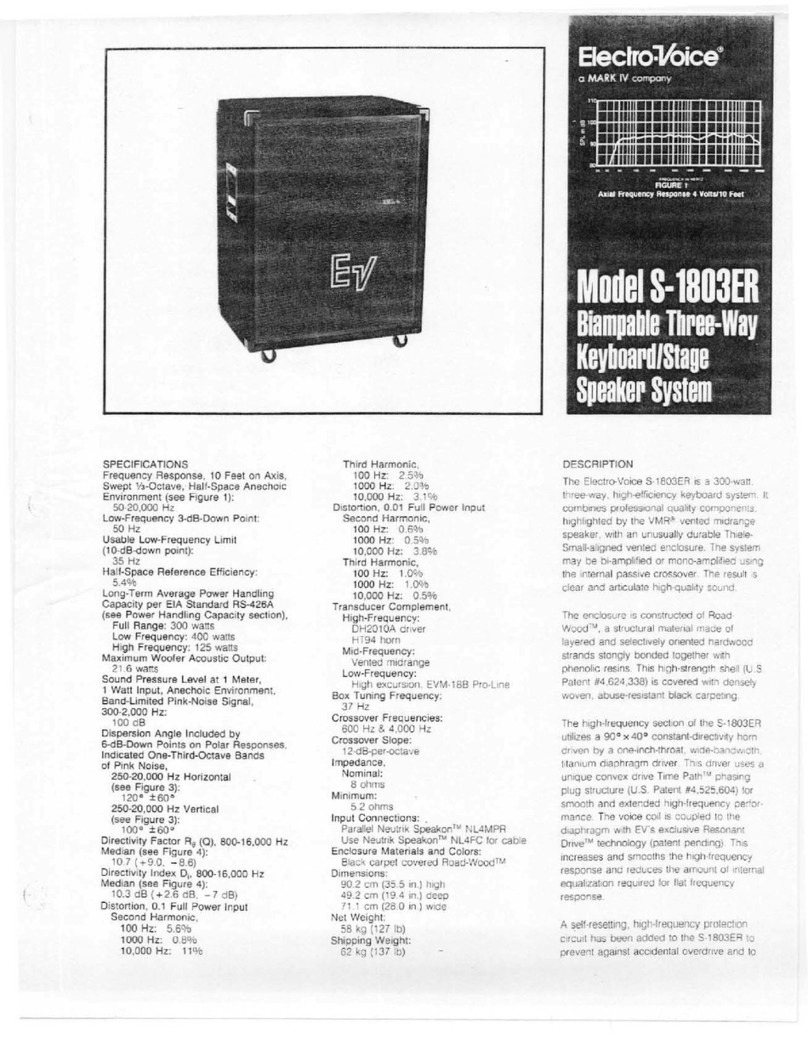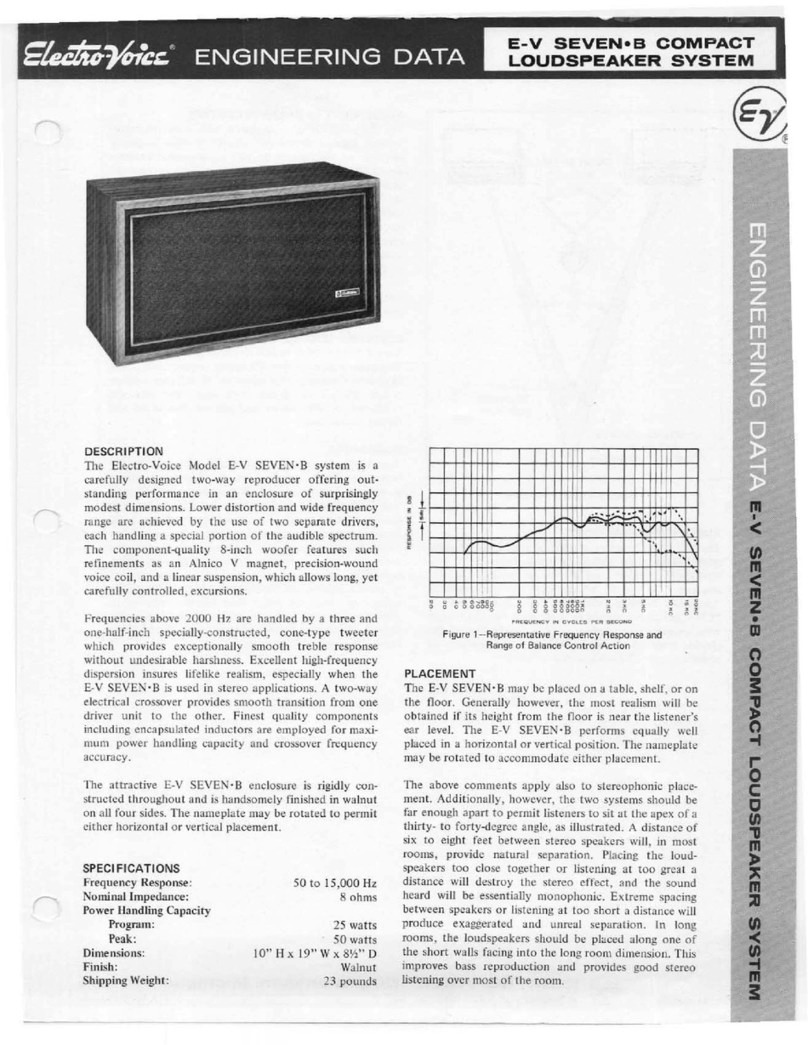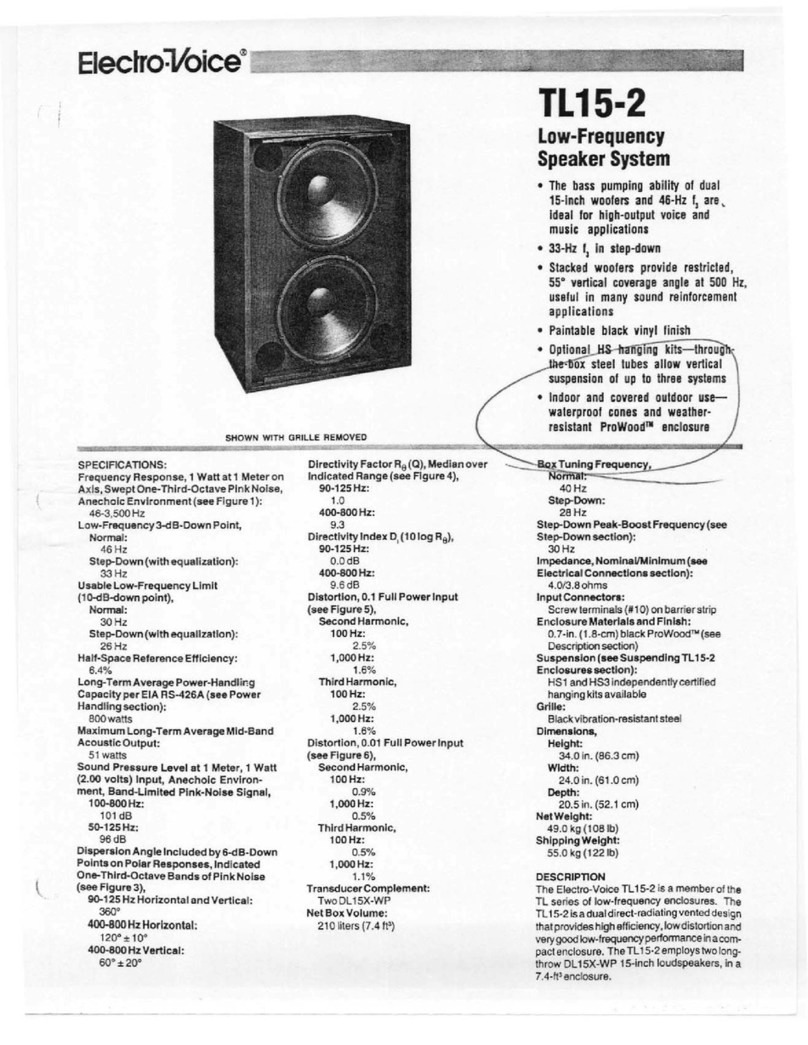
TL606DMT Low-Frequency Speaker System
TL606DMT Low-Frequency Speaker System
3
certified suspension kit shall be available to
suspendtheTL606DMT horizontally (model
HS6) or vertically (model HS7). Internal
1/4-20 threaded fasteners provide a method
of mounting high-frequency or mid-high
devices to the system. The system shall be
the Electro-Voice TL606DMT.
Warranty (Limited)
Electro-Voice products are guaranteed
against malfunction due to defects in mate-
rials or workmanship for a specified period,
as noted in the individual product-line
statement(s)below, or in theindividual prod-
uct data sheet or owner’s manual, beginning
with the date of original purchase. If such
malfunction occurs during the specified pe-
riod, the product will be repaired or replaced
(at our option) without charge. The product
will be returned to the customer prepaid.
Exclusions and Limitations: The Limited
Warranty does not apply to: (a) exterior fin-
ish or appearance; (b) certain specific items
described in the individual product-line
statement(s)below, or in theindividual prod-
uct data sheet or owner’s manual; (c) mal-
function resulting from use or operation of
the product other than as specified in the
product data sheet or owner’s manual; (d)
malfunction resulting from misuse or abuse
of the product; or (e) malfunction occurring
at any time after repairs have been made
to the product by anyone other than
Electro-Voiceor any ofitsauthorized service
representatives. Obtaining Warranty Ser-
vice:To obtain warranty service, a customer
must deliver the product, prepaid, to
Electro-Voice Serviceor any of its authorized
service representatives together with proof
of purchase of the product in the form of a
bill of sale or receipted invoice. A list of au-
thorized service representatives is available
from Electro-Voice Service at 600 Cecil
Street, Buchanan, MI 49107 (800/234-6831
or FAX 616/6955-4743). Incidental and
Consequential Damages Excluded: Prod-
uct repair or replacement and return to the
customer are the only remedies provided to
the customer. Electro-Voice shall not be
liable for any incidental or consequential
damages including, without limitation, in-
jury to persons or property or loss of use.
Some states do not allow the exclusion or
given to the instructions and limitations in
the HS kit instruction sheet.
Accessories for Special Systems
The TL606DMT was designed to be used
withElectro-Voice TransPlanarTM horns, DH
series compression drivers and accessories
to form passive, 500 Hz crossover systems
that may be easily and quickly assembled
and installed. A 500-Hz passive crossover,
the XEQ-504, directly replaces the
TL606DMT’sinput panel.Mountingkits,the
HMK-1 and HMK-2, provide the necessary
hardware and accessories to mount the
HP940/DH1A and HP9040/DH1A horn/
driver combinations, respectively, to the
TL606DMT box. Steel threaded inserts are
provided on the top panel of the box to
accommodate mounting kits for both horn
combinations.
Architects’ and Engineers’
Specifications
The loudspeaker system shall consist of two
380-mm (15-in.) very-low-frequency repro-
ducers installed in a vented enclosure. The
frame of the reproducer shall be manufac-
tured of cast aluminum, and its magnetic as-
semblyshall utilize a ferrite magnet. An alu-
minum ring mounted to the top of the pole
piece shall act as a control on drive induc-
tance and provide a heat-transfer path from
the top of the voice coil. The inner surface
of the top plate shall be coated with
PROTEFTM,a Teflon®-basedcoating used for
prevention of damage to the voice coil.1
Performance specifications of a typical pro-
duction unit shall be as follows: measured
sensitivity (SPL at 1 m on axis with 1 W
input, swept 100-800 Hz) shall be at least
100 dB SPL; usable frequency range shall
extend from 30 Hz to 3,500 Hz; nominal
impedanceshallbe 4 ohms; rated power han-
dling capacity shall be at least 800 watts,
conforming to EIA standard RS-426A.
The enclosure shall be solidly constructed
of19-mm(3/4-in.) stock with all joints tightly
fitted and glued. Overall dimensions shall
be no greater than 100.3 cm (39.5 in.) high
by 57.2 cm (22.5 in.) wide by 44.7 cm
(17.6 in.) deep. Finish shall be black vinyl
with leatherette pattern. An independently
(a3-dB increase in sound pressure level) and
tends to promote the full excitation of more
room modes, or standing waves, important
in achieving maximum overall bass output
in the room. Corner placement (acoustic
eighth space) doubles efficiency again and
guarantees excitation of all room modes.
(Such placement for maximum efficiency
and room-mode excitation is not necessary
and may not be desirable or possible for a
variety of reasons, including aesthetics and
building design.)
The TL606DMT can also be successfully
operated away from any nearby acoustic
boundaries, particularly when multiple
systems are used for increased output ability
(see Use in Multiples section).
Suspending TL606DMT Enclosures
The TL606DMT is designed for typical cin-
ema stage (behind-the-screen) applications
where low-frequency systems are mounted
on platforms, behind the screen and some
distance above the stage floor. The
TL606DMTis not designed to beself-sus-
pended, and if suspended, must be sup-
ported and hung in a way which does not
depand on the structure of the TL606DW
itself for support.
TheHS6andHS7kitsallow the TL606DMT
to be hung safely in a variety of orientations.
The combination of the correct HS kits and
TL606DMT enclosure has been certified by
an independent structural engineer to be safe
and secure. Each HS kit consists of a steel
tube,two brackets, two eyebolts and the nec-
essaryfasteners. The installer must assemble
the HS kit by first drilling two holes into the
TL606DMT enclosure, in predefined posi-
tions, and then screwing the brackets onto
the steel tube, which passes through the en-
closure. An eyebolt is inserted in the T-nut
in the rear panel of the enclosure to provide
a“pull up” to aim the enclosure. Fullinstruc-
tions and hole locations are included with
each cabinet and HS kit. A TL606DMT re-
quires a single HS6 to suspend it horizon-
tally, or a single HS7 to suspend it vertically.
Electro-Voice recommends that only one
TL606DMTbe suspended at one time in
this manner. Vertical is defined as having the
long side vertical. Full attention must be



